A Multidecadal Assessment of Mean and Extreme Wave Climate Observed at Buoys off the U.S. East, Gulf, and West Coasts
Abstract
1. Introduction
2. Data and Methods
2.1. Data and Preprocessing
2.2. Extreme Wave Event Detection
2.3. Trend and Variability Metrics
3. Results and Discussion
3.1. Extreme Wave Climate
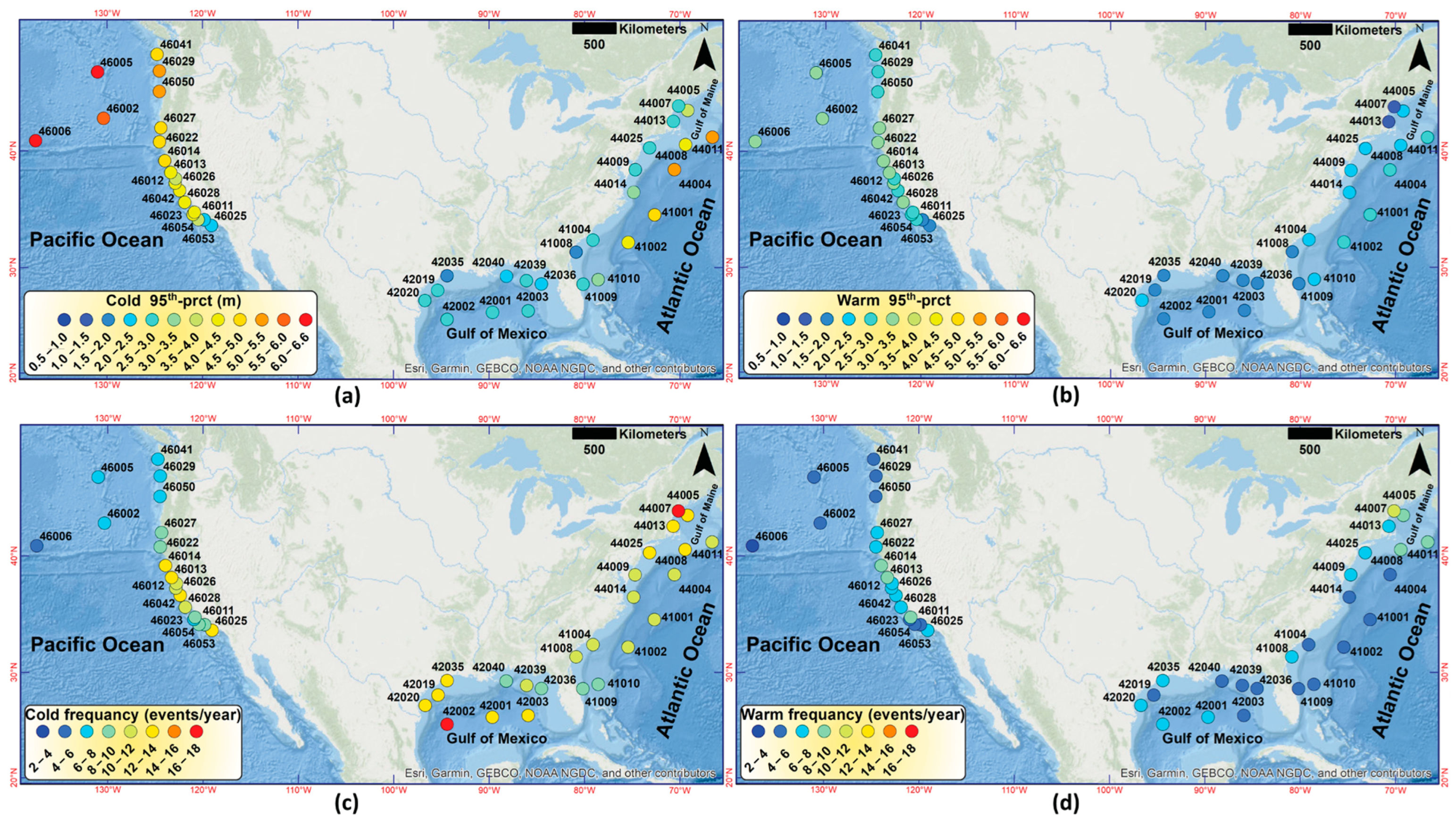
3.2. Seasonal and Interannual Variabilities
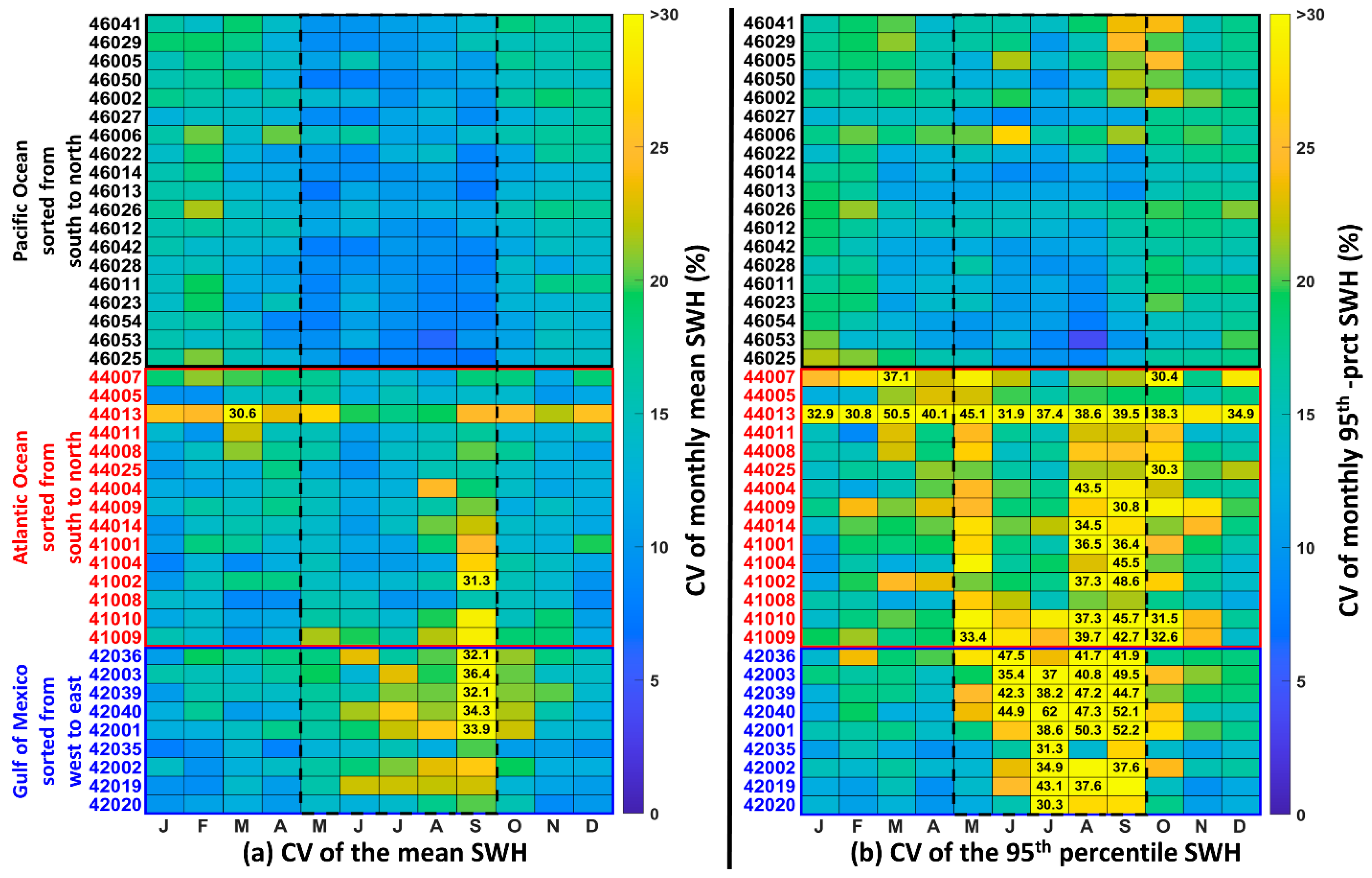

3.3. Decadal and Long-Term Trends
3.3.1. Pacific Ocean
- Cold Season
- Warm Season
- Links to Global Climate and Regional Effects
3.3.2. Atlantic
- Cold Season
- Warm Season
- Links to Global Climate and Regional Effects
3.3.3. Gulf of Mexico
- Cold season
- Warm Season
- Links to Global Climate and Regional Effects
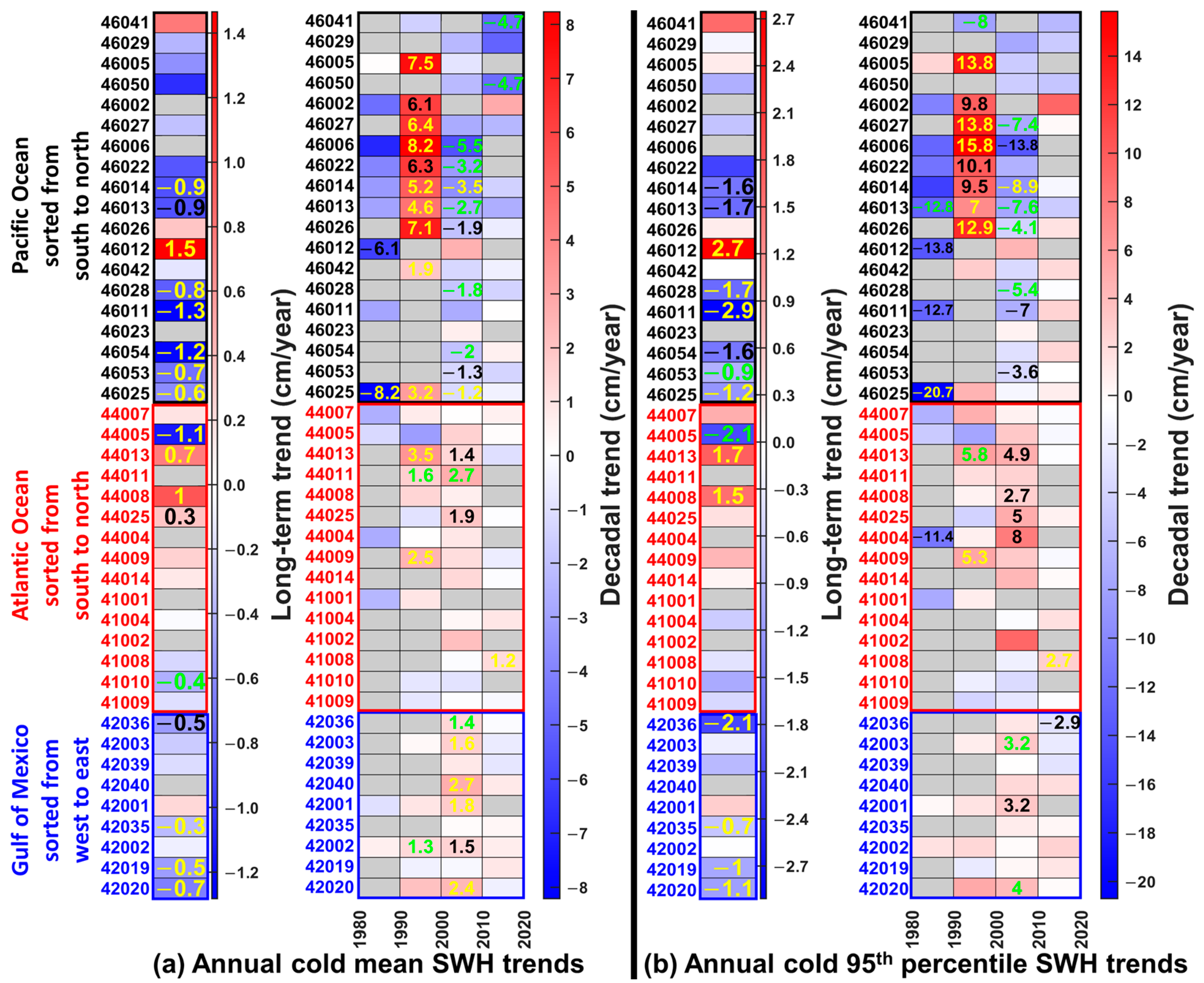
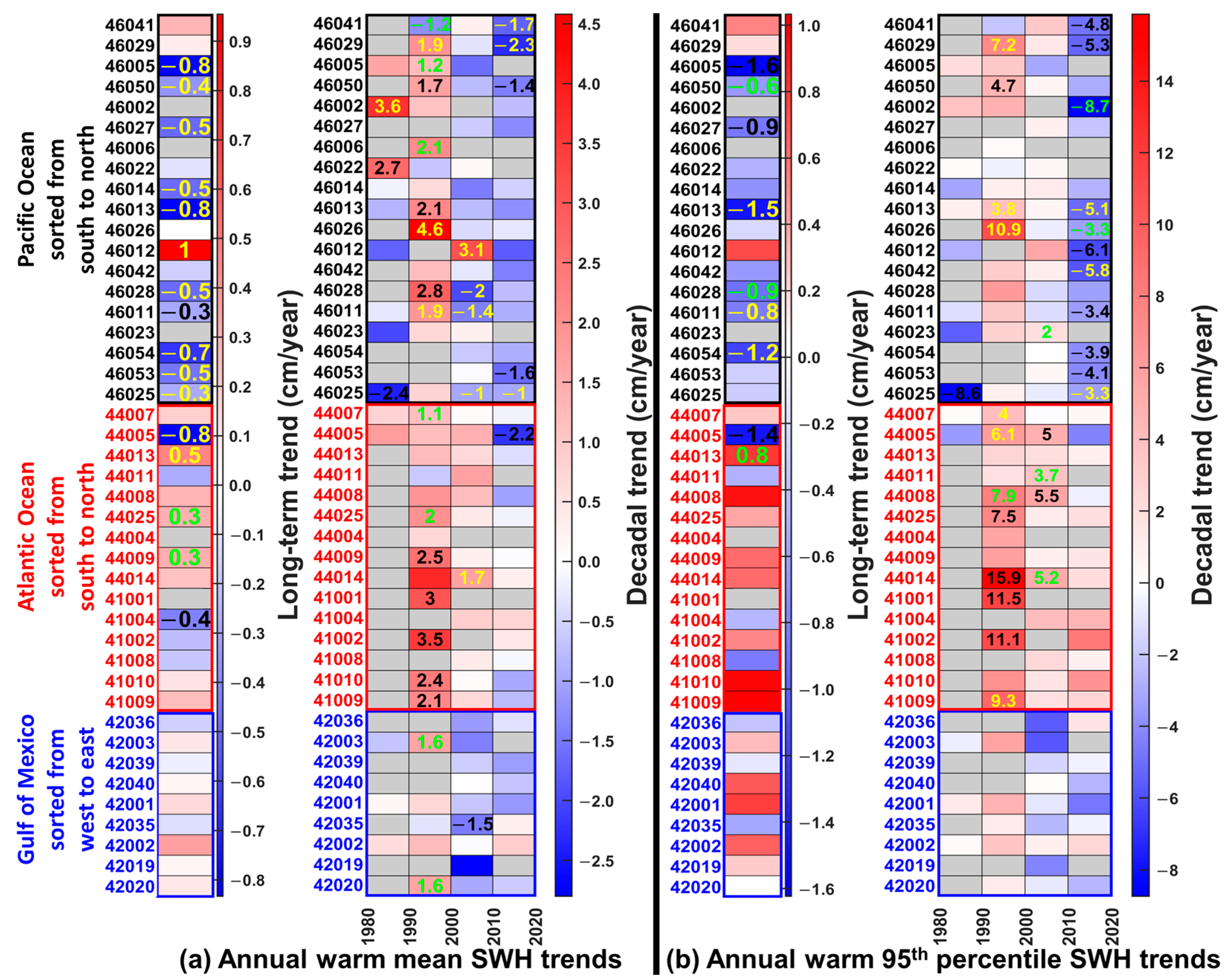
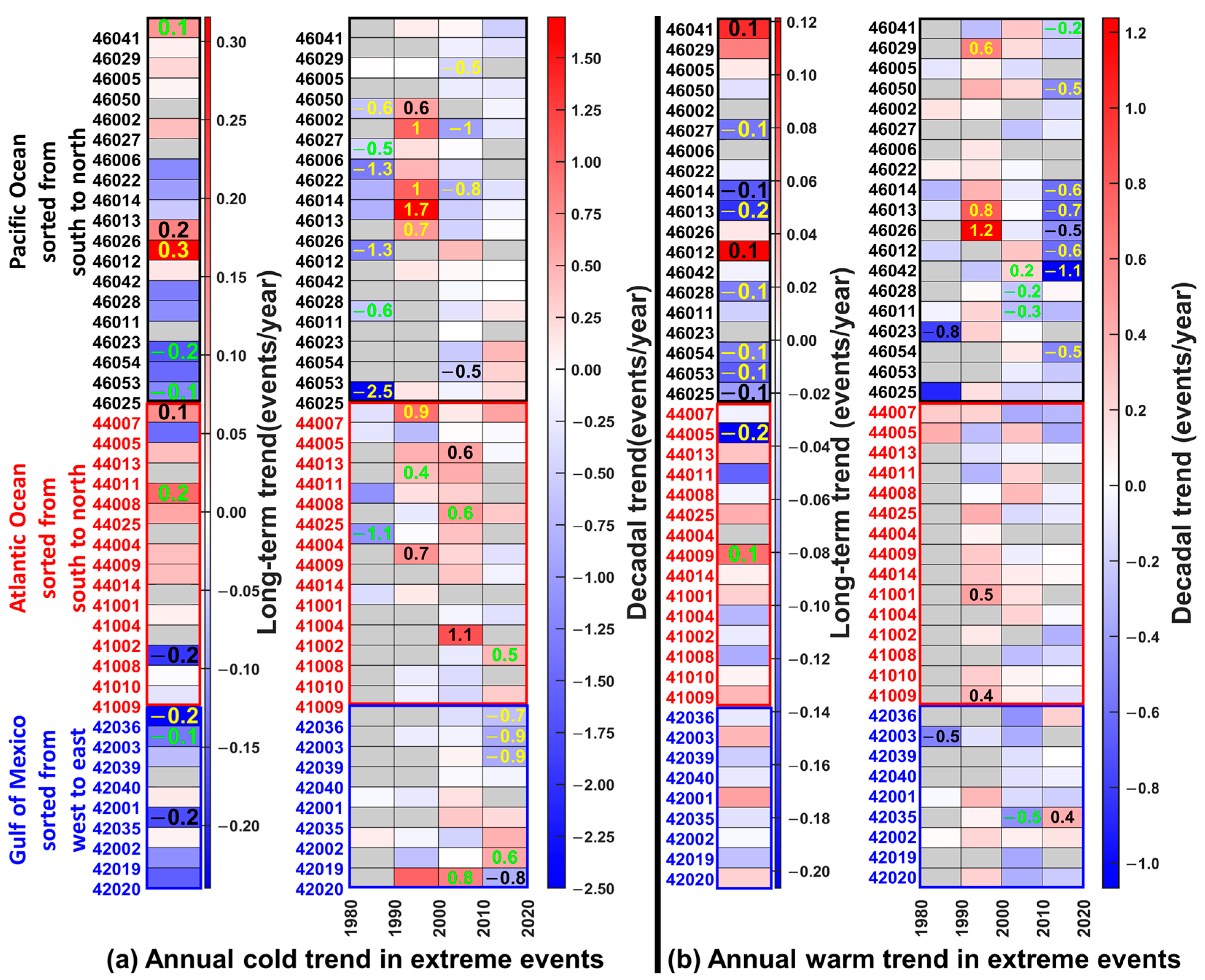
4. Summary and Conclusions
Supplementary Materials
Author Contributions
Funding
Data Availability Statement
Conflicts of Interest
References
- Hansom, J.D.; Switzer, A.D.; Pile, J. Extreme waves: Causes, characteristics, and impact on coastal environments and society. In Coastal and Marine Hazards, Risks, and Disasters; Elsevier: Amsterdam, The Netherlands, 2015; pp. 307–334. [Google Scholar]
- Nederhoff, C.M.; Lodder, Q.J.; Boers, M.; den Bieman, J.P.; Miller, J.K. Modeling the effects of hard structures on dune erosion and overwash: A case study of the impact of Hurricane Sandy on the New Jersey coast. In The Proceedings of the Coastal Sediments; World Scientific Publishing Company: Singapore, 2015. [Google Scholar]
- Gao, J.; Ma, X.; Zang, J.; Dong, G.; Ma, X.; Zhu, Y.; Zhou, L. Numerical investigation of harbor oscillations induced by focused transient wave groups. Coast. Eng. 2020, 158, 103670. [Google Scholar] [CrossRef]
- Gao, J.L.; Lyu, J.; Wang, J.H.; Zhang, J.; Liu, Q.; Zang, J.; Zou, T. Study on Transient Gap Resonance with Consideration of the Motion of Floating Body. China Ocean. Eng. 2022, 36, 994–1006. [Google Scholar] [CrossRef]
- Burkett, V. Global climate change implications for coastal and offshore oil and gas development. Energy Policy 2011, 39, 7719–7725. [Google Scholar] [CrossRef]
- Jamous, M.; Marsooli, R.; Ayyad, M. Global sensitivity and uncertainty analysis of a coastal morphodynamic model using Polynomial Chaos Expansions. Environ. Model. Softw. 2023, 160, 105611. [Google Scholar] [CrossRef]
- Young, I.R. Global Ocean Wave Statistics Obtained from Satellite Observations. Appl. Ocean Res. 1994, 16, 235–248. [Google Scholar] [CrossRef]
- Young, I.R.; Holland, G.J. Atlas of the Oceans: Wind and Wave Climate. Oceanogr. Lit. Rev. 1996, 7, 742. [Google Scholar]
- Young, I.R. Seasonal Variability of the Global Ocean Wind and Wave Climate. Int. J. Climatol. 1999, 19, 931–950. [Google Scholar] [CrossRef]
- Young, I.R.; Vinoth, J.; Zieger, S.; Babanin, A.V. Investigation of Trends in Extreme Value Wave Height and Wind Speed. J. Geophys. Res. Ocean. 2012, 117, C11. [Google Scholar] [CrossRef]
- Young, I.R.; Ribal, A. Multiplatform Evaluation of Global Trends in Wind Speed and Wave Height. Science 2019, 364, 548–552. [Google Scholar] [CrossRef] [PubMed]
- Timmermans, B.W.; Gommenginger, C.P.; Dodet, G.; Bidlot, J.-R. Global Wave Height Trends and Variability from New Multimission Satellite Altimeter Products, Reanalyses, and Wave Buoys. Geophys. Res. Lett. 2020, 47, e2019GL086880. [Google Scholar] [CrossRef]
- Wang, X.L.; Swail, V.R. Changes of Extreme Wave Heights in Northern Hemisphere Oceans and Related Atmospheric Circulation Regimes. J. Clim. 2001, 14, 2204–2221. [Google Scholar] [CrossRef]
- Hemer, M.A.; Church, J.A.; Hunter, J.R. Variability and Trends in the Directional Wave Climate of the Southern Hemisphere. Int. J. Climatol. 2010, 30, 475–491. [Google Scholar] [CrossRef]
- Izaguirre, C.; Méndez, F.J.; Menéndez, M.; Losada, I.J. Global extreme wave height variability based on satellite data. Geophys. Res. Lett. 2011, 38, L10607. [Google Scholar] [CrossRef]
- Reguero, B.G.; Menéndez, M.; Méndez, F.J.; Mı, R.; Losada, I.J. A Global Ocean Wave (GOW) Calibrated Reanalysis from 1948 Onwards. Coast. Eng. 2012, 65, 38–55. [Google Scholar] [CrossRef]
- Gulev, S.K.; Grigorieva, V. Last Century Changes in Ocean Wind Wave Height from Global Visual Wave Data. Geophys. Res. Lett. 2004, 31, L24302. [Google Scholar] [CrossRef]
- Gulev, S.K.; Hasse, L. Changes of wind waves in the North Atlantic over the last 30 years. Int. J. Climatol. J. R. Meteorol. Soc. 1999, 19, 1091–1117. [Google Scholar] [CrossRef]
- Allan, J.; Komar, P. Are Ocean Wave Heights Increasing in the Eastern North Pacific? Eos Trans. Am. Geophys. Union 2000, 81, 561–567. [Google Scholar] [CrossRef]
- Méndez, F.J.; Menéndez, M.; Luceño, A.; Losada, I.J. Estimation of the long-term variability of extreme significant wave height using a time-dependent peak over threshold (pot) model. J. Geophys. Res. Ocean. 2006, 111. [Google Scholar] [CrossRef]
- Méndez, F.J.; Menéndez, M.; Luceño, A.; Medina, R.; Graham, N.E. Seasonality and duration in extreme value distributions of significant wave height. Ocean. Eng. 2008, 35, 131–138. [Google Scholar] [CrossRef]
- Teng, C.C.; Timpe, G.L. Field evaluation of the value-engineered 3-meter discus buoy. In Proceedings of the Challenges of Our Changing Global Environment’. Conference Proceedings. OCEANS’95 MTS/IEEE, San Diego, CA, USA, 9–12 October 1995. [Google Scholar]
- Chung-Chu, T.; Mettlach, T.; Chaffin, J.; Bass, R.; Bond, C.; Carpenter, C.; Dinoso, R.; Hellenschmidt, M.; Bernard, L. National Data Buoy Center 1.8-Meter Discus Buoy, Directional Wave System. In Proceedings of the OCEANS ‘95 MTS/IEEE “CHALLENGES OF OUR CHANGING GLOBAL ENVIRONMENT, San Diego, CA, USA, 9–12 October 2007; pp. 1–9. [Google Scholar]
- Riley, R.E.; Bouchard., R.H. An Accuracy Statement for the Buoy Heading Component of NDBC Directional Wave Measurements. In The Twenty-Fifth International Ocean and Polar Engineering Conference; OnePetro: Richardson, TX, USA, 2015. [Google Scholar]
- Gemmrich, J.; Thomas, B.; Bouchard, R. Observational Changes and Trends in Northeast Pacific Wave Records. Geophys. Res. Lett. 2011, 38, L22601. [Google Scholar] [CrossRef]
- Hall, C.; Jensen, R. Utilizing Data from the NOAA National Data Buoy Center; Engineering Research and Development Center: Vicksburg, MS, USA, 2021; p. 20. [Google Scholar]
- Hall, C.; Jensen, R. USACE Coastal and Hydraulics Laboratory Quality Controlled, Consistent Measurement Archive. Sci. Data 2022, 9, 1–9. [Google Scholar] [CrossRef] [PubMed]
- Leyva, D.J. Uncertainties of Multi-Decadal Buoy and Altimeter Observations. Ph.D. Thesis, University of Hawaii at Manoa, Honolulu, HI, USA, 2020. [Google Scholar]
- Peter, R.; Komar, P.; Allan, J. Increasing Wave Heights and Extreme Value Projections: The Wave Climate of the US Pacific Northwest. Coast. Eng. 2010, 57, 539–552. [Google Scholar]
- Gower, J.F.R. Temperature, Wind and Wave Climatologies, and Trends from Marine Meteorological Buoys in the Northeast Pacific. J. Clim. 2002, 15, 3709–3718. [Google Scholar] [CrossRef]
- Allan, C.J.; Komar, P.D. Climate Controls on US West Coast Erosion Processes. J. Coast. Res. 2006, 22, 511–529. [Google Scholar] [CrossRef]
- Stuart, C.; Bawa, J.; Trenner, L.; Dorazio, P. An Introduction to Statistical Modeling of Extreme Values; Springer: Berlin/Heidelberg, Germany, 2001; Volume 208, p. 208. [Google Scholar]
- Beguería, S. Uncertainties in Partial Duration Series Modelling of Extremes Related to the Choice of the Threshold Value. J. Hydrol. 2005, 303, 215–230. [Google Scholar] [CrossRef]
- Luceño, A.; Menéndez, M.; Méndez, F.J. The effect of temporal dependence on the estimation of the frequency of extreme ocean climate events. Proc. R. Soc. A Math. Phys. Eng. Sci. 2006, 462, 1683–1697. [Google Scholar] [CrossRef]
- Lopatoukhin, L.J.; Rozhkov, V.A.; Ryabinin, V.E.; Swail, V.R.; Boukhanovsky, A.V.; Degtyarev, A.B. Estimation of Extreme Wind Wave Heights; WMO & IOC: Geneva, Switzerland, 2000. [Google Scholar]
- Young, I.R.; Zieger, S.; Babanin, A.V. Global trends in wind speed and wave height. Science 2011, 332, 451–455. [Google Scholar] [CrossRef]
- Shanas, R.; Kumar, V.S. Trends in Surface Wind Speed and Significant Wave Height as Revealed by ERA-Interim Wind Wave Hindcast in the Central Bay of Bengal. Int. J. Climatol. 2015, 35, 2654–2663. [Google Scholar] [CrossRef]
- Günther, H.; Rosenthal, W.; Stawarz, M.; Carretero, J.C.; Gomez, M.; Lozano, I.; Serrano, O.; Reist, M. The Wave Climate of the Northeast Atlantic over the Period 1955–1994: The WASA Wave Hindcast. Glob. Atmos. Ocean. Syst. 1997, 6. [Google Scholar]
- Stopa, J.E.; Ardhuin, F.; Girard-Ardhuin, F. Wave Climate in the Arctic 1992–2014: Seasonality and Trends. Cryosphere 2016, 10, 1605–1629. [Google Scholar] [CrossRef]
- Charles, E.; Idier, D.; Delecluse, P.; Déqué, M.; Le Cozannet, G. Climate change impact on waves in the Bay of Biscay, France. Ocean. Dyn. 2012, 62, 831–848. [Google Scholar] [CrossRef]
- Marsooli, R.; Jamous, M.; Miller, J.K. Climate change impacts on wind waves generated by major tropical cyclones off the coast of New Jersey, USA. Front. Built Environ. 2021, 161. [Google Scholar] [CrossRef]
- Corti, S.; Giannini, A.; Tibaldi, S.; Molteni, F. Patterns of Low-Frequency Variability in a Three-Level Quasi-Geostrophic Model. Clim. Dyn. 1997, 13, 883–904. [Google Scholar] [CrossRef]
- Chen, T.C.; Yoon, J.H. Interdecadal variation of the North Pacific wintertime blocking. Mon. Weather Rev. 2002, 130, 3136–3143. [Google Scholar] [CrossRef]
- Mathiesen, M.; Goda, Y.; Hawkes, P.J.; Mansard, E.; Martín, M.J.; Peltier, E.; Van Vledder, G. Recommended practice for extreme wave analysis. J. Hydraul. Res. 1994, 32, 803–814. [Google Scholar] [CrossRef]
- Box, G.E.; Jenkins, G.M.; Reinsel, G.C.; Ljung, G.M. Time Series Analysis: Forecasting and Control; John Wiley & Sons: Hoboken, NJ, USA, 2015. [Google Scholar]
- Pérez, J.; Méndez, F.J.; Menéndez, M.; Losada, I.J. ESTELA: A method for evaluating the source and travel time of the wave energy reaching a local area. Ocean. Dyn. 2014, 64, 1181–1191. [Google Scholar] [CrossRef]
- Alves Jose-Henrique, G.M. Numerical Modeling of Ocean Swell Contributions to the Global Wind-Wave Climate. Ocean Model. 2006, 11, 98–122. [Google Scholar] [CrossRef]
- Alvaro, S.; Sušelj, K.; Rutgersson, A.; Sterl, A. A Global View on the Wind Sea and Swell Climate and Variability from ERA-40. J. Clim. 2011, 24, 1461–1479. [Google Scholar]
- Joaquim, G.P.; Bellenbaum, N.; Karremann, M.K.; Della-Marta, P.M. Serial Clustering of Extratropical Cyclones over the North Atlantic and Europe Under Recent and Future Climate Conditions. J. Geophys. Res. Atmos. 2013, 118, 12–476. [Google Scholar]
- Allison, C.M.; Lackmann, G.M. Climatological Changes in the Extratropical Transition of Tropical Cyclones in High-Resolution Global Simulations. J. Clim. 2019, 32, 8733–8753. [Google Scholar]
- Appendini, C.M.; Torres-Freyermuth, A.; Salles, P.; López-González, J.; Mendoza, E.T. Wave Climate and Trends for the Gulf of Mexico: A 30-Yr Wave Hindcast. J. Clim. 2014, 27, 1619–1632. [Google Scholar] [CrossRef]
- Appendini, C.M.; Urbano-Latorre, C.P.; Figueroa, B.; Dagua-Paz, C.J.; Torres-Freyermuth, A.; Salles, P. Wave Energy Potential Assessment in the Caribbean Low Level Jet Using Wave Hindcast Information. Appl. Energy 2015, 137, 375–384. [Google Scholar] [CrossRef]
- Reading, P.J. The Central American Cold Surge: An Observational Analysis of the Deep South-Ward Penetration of North American Cold Fronts. Master’s Thesis, Texas A&M University, College Station, TX, USA, 1992. [Google Scholar]
- Osorio, A.F.; Montoya, R.D.; Ortiz, J.C.; Peláez, D. Construction of Synthetic Ocean Wave Series Along the Colombian Caribbean Coast: A Wave Climate Analysis. Appl. Ocean Res. 2016, 56, 119–131. [Google Scholar] [CrossRef]
- Wang, C. Variability of the Caribbean Low-Level Jet and Its Relations to Climate. Clim. Dyn. 2007, 29, 411–422. [Google Scholar] [CrossRef]
- Reguero, B.G.; Losada, I.J.; Méndez, F.J. A Global Wave Power Resource and Its Seasonal, Interannual and Long-Term Variability. Appl. Energy 2015, 148, 366–380. [Google Scholar] [CrossRef]
- Julien, B.; Santiago, L.; Almar, R.; Kestenare, E. Coastal Wave Extremes Around the Pacific and Their Remote Seasonal Connection to Climate Modes. Climate 2021, 9, 168. [Google Scholar]
- Eichler, T.; Wayne, H. Climatology and ENSO-Related Variability of North American Extratropical Cyclone Activity. J. Clim. 2006, 19, 2076–2093. [Google Scholar] [CrossRef]
- Seymour, R.J. Effects of El Niños on the West Coast Wave Climate. Shore Beach 1998, 66, 3–6. [Google Scholar]
- Simon, C.S.; Croci-Maspoli, M.; Schwierz, C.; Appenzeller, C. Two-Dimensional Indices of Atmospheric Blocking and Their Statistical Relationship with Winter Climate Patterns in the Euro-Atlantic Region. Int. J. Climatol. 2006, 26, 233–249. [Google Scholar]
- Emily, G.; Gallagher, S.; Clancy, C.; Dias, F. NAO and Extreme Ocean States in the Northeast Atlantic Ocean. Adv. Sci. Res. 2017, 14, 23–33. [Google Scholar]
- Jorge, A.K.; Appendini, C.M.; Beier, E.; Sosa-López, A.; López-González, J.; Posada-Vanegas, G. Oceanic and Atmospheric Impact of Central American Cold Surges (Nortes) in the Gulf of Mexico. Int. J. Climatol. 2021, 41, E1450–E1468. [Google Scholar]
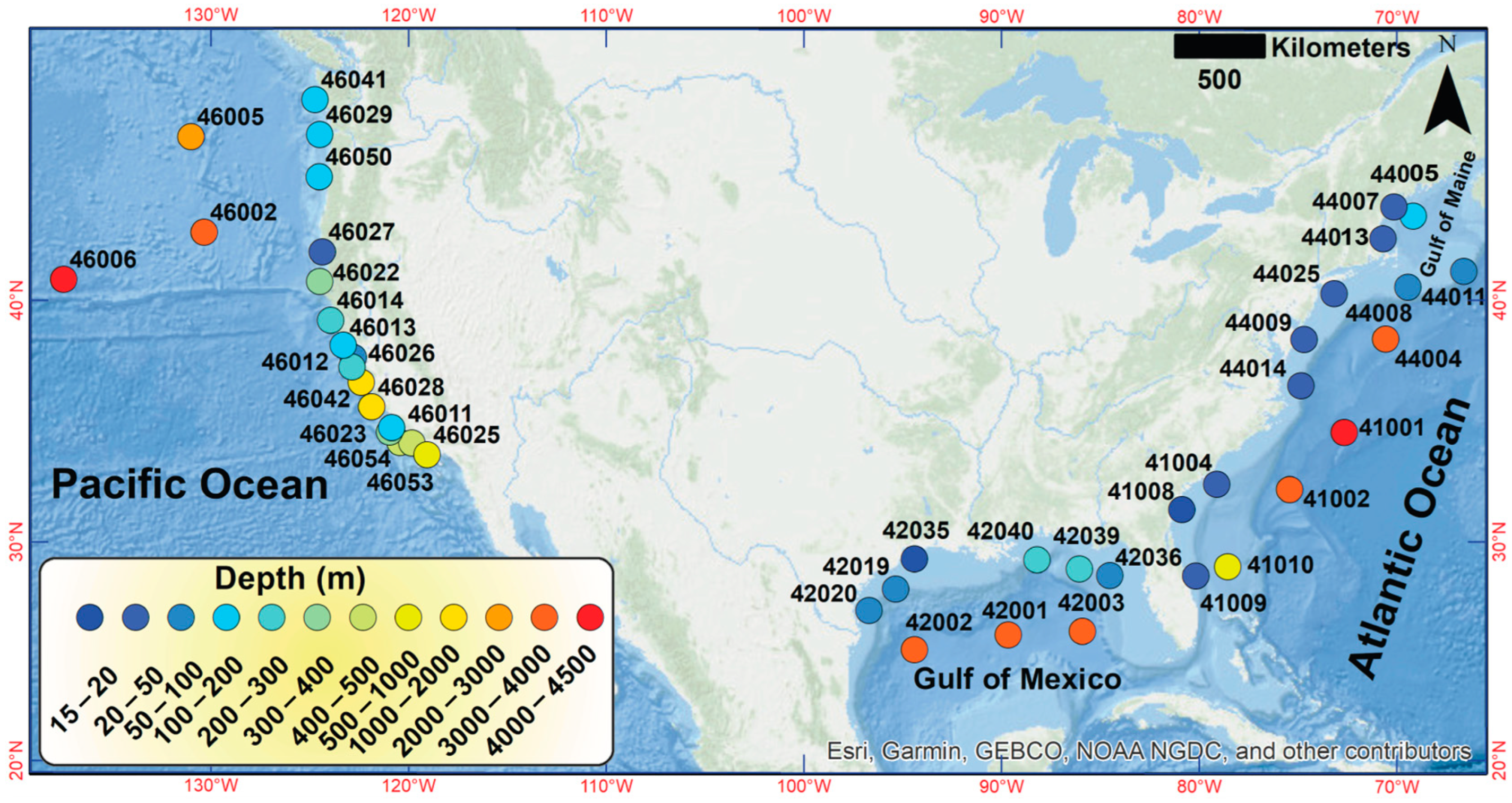
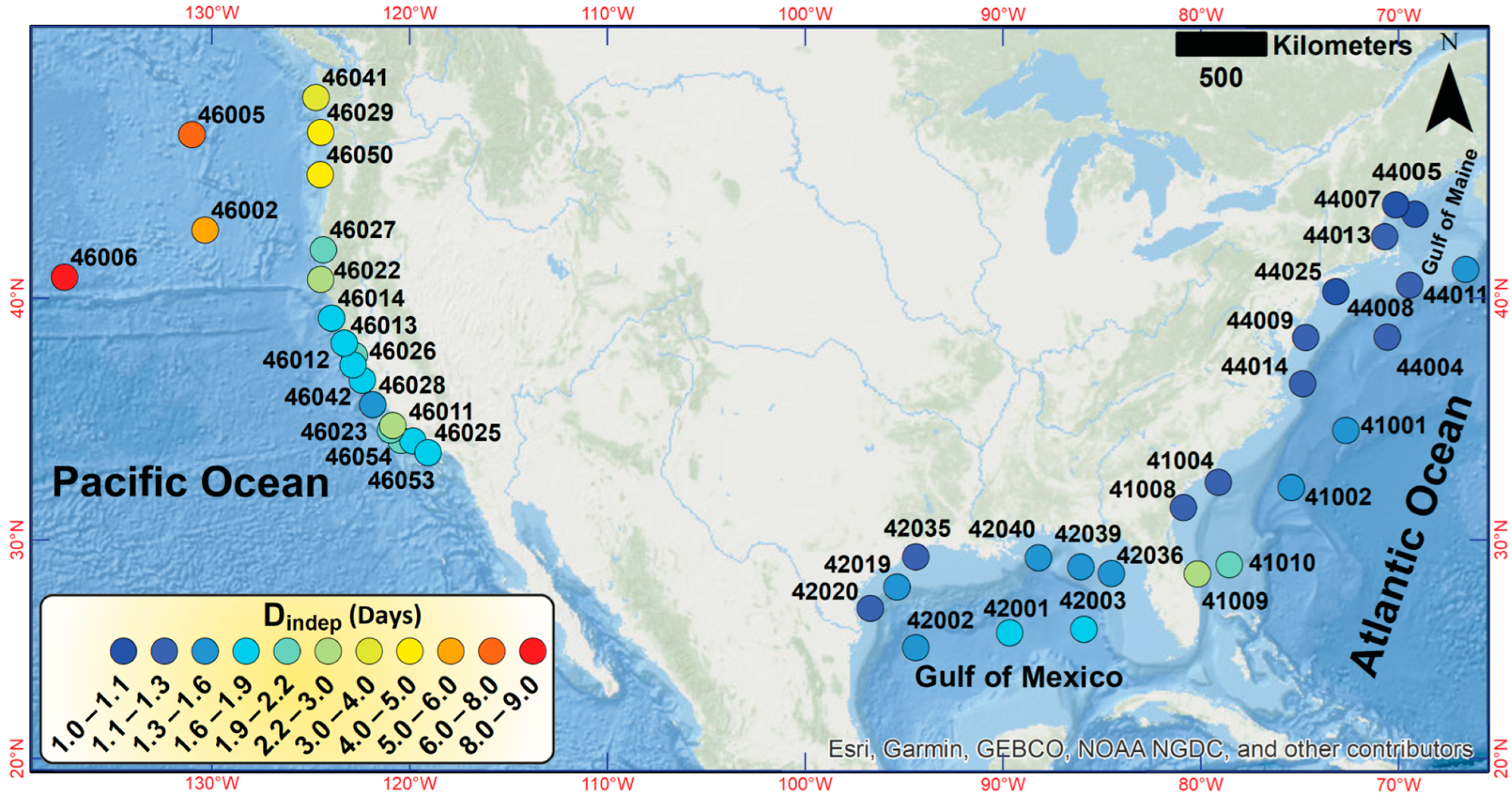
Disclaimer/Publisher’s Note: The statements, opinions and data contained in all publications are solely those of the individual author(s) and contributor(s) and not of MDPI and/or the editor(s). MDPI and/or the editor(s) disclaim responsibility for any injury to people or property resulting from any ideas, methods, instructions or products referred to in the content. |
© 2023 by the authors. Licensee MDPI, Basel, Switzerland. This article is an open access article distributed under the terms and conditions of the Creative Commons Attribution (CC BY) license (https://creativecommons.org/licenses/by/4.0/).
Share and Cite
Jamous, M.; Marsooli, R. A Multidecadal Assessment of Mean and Extreme Wave Climate Observed at Buoys off the U.S. East, Gulf, and West Coasts. J. Mar. Sci. Eng. 2023, 11, 916. https://doi.org/10.3390/jmse11050916
Jamous M, Marsooli R. A Multidecadal Assessment of Mean and Extreme Wave Climate Observed at Buoys off the U.S. East, Gulf, and West Coasts. Journal of Marine Science and Engineering. 2023; 11(5):916. https://doi.org/10.3390/jmse11050916
Chicago/Turabian StyleJamous, Mohammad, and Reza Marsooli. 2023. "A Multidecadal Assessment of Mean and Extreme Wave Climate Observed at Buoys off the U.S. East, Gulf, and West Coasts" Journal of Marine Science and Engineering 11, no. 5: 916. https://doi.org/10.3390/jmse11050916
APA StyleJamous, M., & Marsooli, R. (2023). A Multidecadal Assessment of Mean and Extreme Wave Climate Observed at Buoys off the U.S. East, Gulf, and West Coasts. Journal of Marine Science and Engineering, 11(5), 916. https://doi.org/10.3390/jmse11050916






